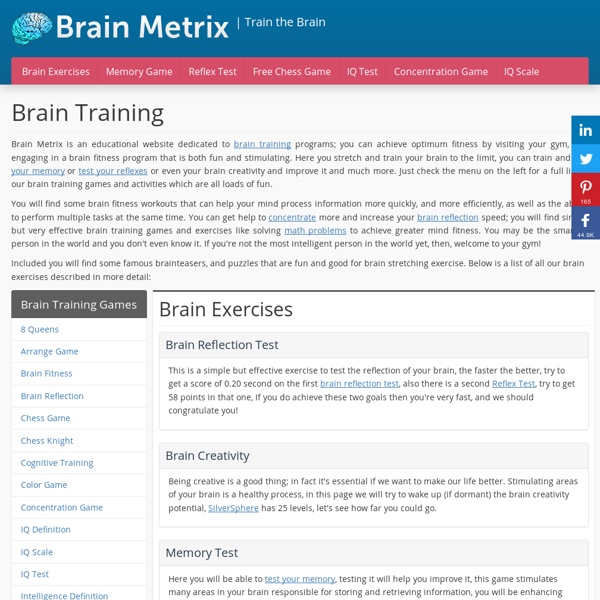



Learning Styles Assessment Printer-Friendly Version Learning styles refer to the ways you prefer to approach new information. Each of us learns and processes information in our own special ways, though we share some learning patterns, preferences, and approaches. Knowing your own style also can help you to realize that other people may approach the same situation in a different way from your own. Take a few minutes to complete the following questionnaire to assess your preferred learning style. Begin by reading the words in the left-hand column. Chinese Language Blog: Language and Culture of the Chinese-Speaking World Honoring the deceased for Qing Ming Jie. Today is a national holiday in China, the Clear Brightness Festival (清明节 – qīng míng jié). Taking place two weeks after the vernal equinox, this is one of the few Chinese holidays that follows the solar calendar.
All of the energy in the universe is... - George Zaidan and Here's a great lecture from MIT about Work, Energy, and Universal Gravitation.Here is some basic information on kinetic theory ideas about solids, liquids and gases, and changes of state. Also, there's information about ideal and real gases, the ideal gas equation, and Boyle's Law and Charles' Law.Students are often confused about issues relating to chemical bond energy, thinking that chemical bonds store energy that is used to make them. Check out this article to clear up any confusion!Here's a blog post by Dr. Brain Atlas - Introduction The central nervous system (CNS) consists of the brain and the spinal cord, immersed in the cerebrospinal fluid (CSF). Weighing about 3 pounds (1.4 kilograms), the brain consists of three main structures: the cerebrum, the cerebellum and the brainstem. Cerebrum - divided into two hemispheres (left and right), each consists of four lobes (frontal, parietal, occipital and temporal). The outer layer of the brain is known as the cerebral cortex or the ‘grey matter’.
Online Language Instruction Join Learn Speak Together! The Most Complete Online Language Learning Course Available What will I get? Transparent Connect Classroom is the ultimate solution for learners seeking guidance from an expert instructor. Online Creative Writing Courses Offered Free by Top Universities and Educational Websites Getting Educated for Free 1. Introductory Courses Introduction to Creative Writing - University of Utah Course Creative Writing 101 - Eight Lesson Suite101 Course Intro to Creative Writing - Eight Week Course from the Crafty Writer Creative Writing Workshop - Four Lesson Suite 101 Course Writing What You Know - Introductory Course from the UK's Open University 2.
Creative Writing 101 RJ Great article. Morning is definitely the time where I am most creative. I think it’s because my mind is the freshest and the least cluttered at this time of day. History of architecture The Architect's Dream by Thomas Cole (1840) shows a vision of buildings in the historical styles of the Western tradition, from Ancient Egypt through to Classical Revival A view of Chuo-ku, Osaka, Japan showing buildings of a modern Asian city, ranging from the medieval Osaka Castle to skyscrapers The history of architecture traces the changes in architecture through various traditions, regiões, overarching stylistic trends, and dates. The branches of architecture are civil, sacred, naval, military,[1] and landscape architecture.
GTD in 15 minutes – A Pragmatic Guide to Getting Things Done GTD—or “Getting things done”—is a framework for organizing and tracking your tasks and projects. Its aim is a bit higher than just “getting things done”, though. (It should have been called “Getting things done in a much better way than just letting things happen, which often turns out not to be very cool at all”.) Its aim is to make you have 100% trust in a system for collecting tasks, ideas, and projects—both vague things like “invent greatest thing ever” and concrete things like “call Ada 25 August to discuss cheesecake recipe”. Classical Orders of Architecture Of the three columns found in Greece, Doric columns are the simplest. They have a capital (the top, or crown) made of a circle topped by a square. The shaft (the tall part of the column) is plain and has 20 sides.
Victorian Architecture Oh, those amazing Victorian builders! Born during the Industrial Revolution, they embraced new materials and technologies to create houses like no one had ever seen before. Mass-production and mass-transit made ornamental parts affordable. Victorian architects and builders applied decoration liberally, combining features borrowed from many different eras with flourishes from their own imaginations. When you look at a house built during the Victorian era, you might see Greek Revival pediments, Federalist Style balustrades, and other Colonial Revival details. American Impressionism: Reminiscences and Reflections on Collecting - NGA Reminiscences and Reflections on Collecting Raymond Horowitz These remarks, slightly revised and edited, are taken from a talk delivered at the conference "Expanding Horizons: American Painting 1865 - 1930," held at New York University on 25 April 1996. page 1 of 5 A collector, when talking about his or her collection, runs the risk of appearing either immodest or falsely modest, as well as of repeating the usual tiresome clichés about art collecting.